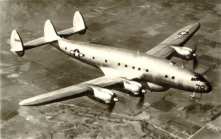 |
C-121, US Air Force
(picture supplied by Jean-Pierre Lauwers) |
Lockheed Constellation
| History |
During 1939, Trans Continental and Western Air (to become TWA) issued a requirement to Lockheed for a 40-passenger airliner. Howard Hughes, major stockholder in TWA, insisted on keeping the project a secret one, so that his company would benefit from a commercial lead over its competitors. Lockheed responded to the request with a four-engined aircraft, which first flew on January 9, 1943. Unfortunately, war precluded any secrecy and, indeed, commercial use. The USAAF ordered several aircraft as C-69 transports. Being a complicated machine, the C-69 suffered from a protracted development period and only a handful effectively flew with US military insignia in the later stages of the war. With military requirements dwindling after the war, aircraft on the production lines originally intended for the USAAF were converted into civil airliners, designated L-049. Both PanAm and TWA took delivery of the earliest examples, later followed by BOAC in England. In high-density layout, up to 60 passengers could be carried. The first true civilian Constellation was the L-649, accomodating a maximum of 81 passengers. It was followed on the production lines by the longer-ranging L-749. Apart from the long-range tanks in the wings, there were no notable differences between these variants. The later version also served in several European airlines, including Air France and KLM. A further upgraded version saw the light of day under the designation L-1049 Super Constellation. Compared to its predecessors, it was lengthened and more powerful. In its L-1049C form it was equipped with 3250 hp Wright R-3350-DA1 Turbo-Compound engines. These complicated engines soon gave the aircraft the soubriquet of 'the worlds best THREE-engined aircraft'. Indeed, numerous were the cases of one engine cutting out or getting on fire during flight, usually without any further consequences. The L-1049G version had provision for wingtip tanks, further increasing range. The last stage in Constellation development was the L-1649 Starliner. It was a much refined version of the earlier L-1049 with a completely new wing. It entered service during the late fifties, mainly on the North Atlantic route, but rivalling the new jet aircraft from Boeing (the 707) and Douglas (DC 8) proved impossible and production came to a stop after only 43 had been built. (additional info supplied by Dave Crane) |
| Some technical data |
| L-749A | L-1049C | L-1649 | |
| Wing span | 37.49 m | 37.49 m | 45.72 m |
| Length | 29.00 m | 34.62 m | 34.62 m |
| Height | 7.21 m | 7.54 m | 7.14 m |
| Maximum weight | 48535 kg | 62370 kg | 70761 kg |
| Empty weight | 27280 kg | 33120 kg | 38675 kg |
| Cruise speed | 480 km/h | 570 km/h | 550 km/h |
| Range | 4830 km | 7435 km | 10170 km |
| Passenger seats (typical) | 43 | 95 | 92 |
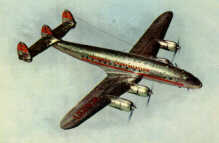 |
NC91207, one of the early Connies in Lockheed demonstator colors. (one of a series of cards depicting American civil and military aircraft - origins unknown) |
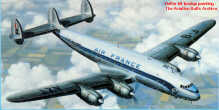 |
Heller's colorful boxtop art for their nice 1/72 scale L-749. It shows F-BAZT, an Air France machine, above continental Europe. |

|
L-1049G VH-EAG, a preserved example flying in Australia. FIring up the engines can be taken quite literally, with flames belching out of the exhaust tubes. (Pictures supplied by Randal McFarlane) |
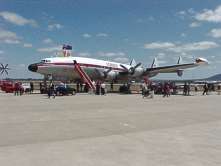
|
VH-EAG again... photographed at
Avalon (top) and Nowra (bottom) (pictures used by kind permission of Darryl Gibbs, CNAPG) |
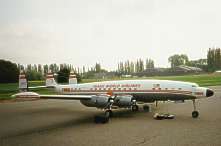 |
Lockheed L.1649
Starliner scale model Apart from the 2-blade props, this flying scale model looks extremely convincing. (picture provided by Stef De Wit) |
If you entered this page directly and want to check out the rest of my website : click here to go to my Homepage. |
Last update : 10-05-02 (c) Guido Van Roy